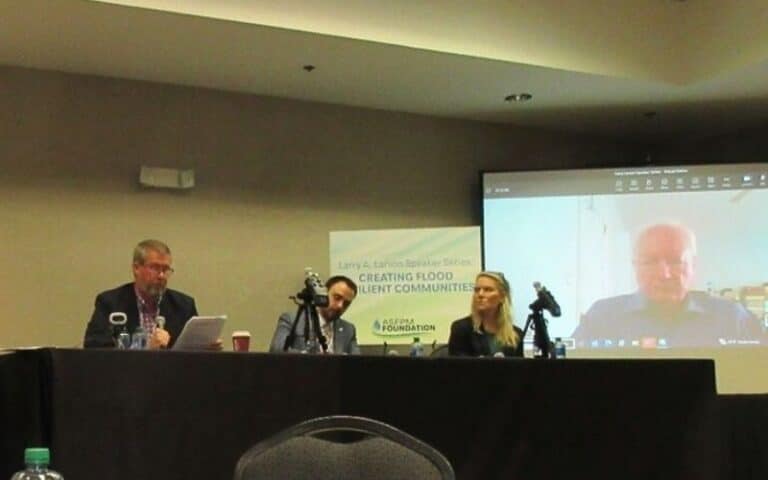New Resource Works to Preserve and Celebrate ASFPM’s History

At the 2023 ASFPM Annual Conference in Raleigh, we announced the launch of a new online resource developed to preserve and celebrate the legacy of the people and activities who made significant and enduring contributions to flood risk management, the association, and the floodplain management profession as a whole.
The ASFPM Story features both a Wall of Honor and a timeline of Association Milestones. When you go to the webpage, you can scroll through the timeline to read about the history of how the nation has managed flood risk over the past 100+ years and ASFPM’s role in these efforts. You can also click on the Wall of Honor button to toggle over to the Wall to learn more about the men and women (primarily volunteers) who helped build the association from the formative years through the era of growth and expansion.
When you visit the webpage, you will note that Gilbert White is listed first on the milestones, because it was Gilbert whose research and papers told the nation’s leaders and Congress we were managing flood risk poorly and it was time to stop thinking we could control Mother Nature by adjusting our river and coasts with dams, channels, and levees (which we had been doing for 150 years) and instead start adjusting human behavior by mapping flood risk and guiding development away from high flood risk areas. His efforts moved the U.S. to enact programs like the NFIP in an attempt to regulate development in high-risk areas and move people away from flood risk areas.
It is interesting that a number of states were already mapping and regulating development in flood risk areas before Congress created the NFIP in 1968. Many of those states were in the Midwest in Region 5 (Michigan, Illinois, Ohio, Indiana, Minnesota, and Wisconsin) and some states in the Northeast along with Iowa. These states had passed laws directing their agencies (mostly within their Department of Natural Resource) to map flood risk and require communities to adopt regulations to guide development in those flood risk areas.
On the Wall of Honor, you will see the name of Jon Kusler, who wrote model state legislation and regulations and model zoning ordinances for local communities to adopt to enforce those regulations, using language that would avoid “taking” private property rights. For example, I ran the Wisconsin floodplain program where I had engineers mapping floodplains and planners working with our 500+ communities to adopt and enforce our state regulations (which are more restrictive than the NFIP regulations in important ways, such as freeboard and no rise floodways).
While ASFPM was originally formed by states, we were influenced by key people like Janie Douglas from impoverished and heavily flooded Harlan County, Kentucky, who encouraged us to make sure we were helping those small communities get the information they needed on how to reduce their flood risk and protect their people and property.
I urge you to look at other milestones (like the first meeting of ASFPM in 1976 and our role in flood risk management) and Wall of Honor volunteers who were key to the ASFPM growth and evolution. People like French Wetmore, Dan Accurti, Rebecca Quinn, John Ivey, and many others. You can click on their name and bring up the history of the things they did and the far-reaching impacts.
Understanding the power of relationships — among our members and leaders as well as our partner organizations and federal agencies — was and is a key factor in the growth and effectiveness of ASFPM in working toward our mission to reduce the nation’s flood loss. Both Gilbert White and Jon Kusler taught us to organize our meetings and conferences to provide lots of opportunities for everyone there to connect and build those relationships, and we saw that again firsthand in Raleigh. Throughout the 1970s and 1980s, Gilbert pulled all federal agencies together each year at the Natural Hazards Center at the University of Colorado-Boulder and urged them to work closely with ASFPM, because our members were the “boots on the ground” actually guiding development in flood risk areas.
The backstory behind the ASFPM Story
The genesis of the new website was much like so many things over the years — it began with a conversation among some of our early pioneers. In reviewing our website, we realized we haven’t yet told the history of ASFPM or the work performed by key volunteers and others who helped form, grow, and evolve the organization into what we are today.
I sat down with Diane Brown, our first and longest serving employee, and others to map out the best way to begin telling our story. Diane (who retired in 2018) and I volunteered our time to undertake the project to accomplish this, along with the help of Mary Bart, Jen Niles, and Louie Greenwell here at ASFPM. When possible, we reached out to those key volunteers featured on the Wall of Honor to help us draft the profiles and fact-check key dates and activities.
It’s important to note, this is only version 1.0 of the ASFPM Story. We will continue to add more milestones and profiles in the coming years. If you have suggestions for activities or people that we should include, please let us know.




